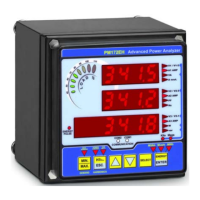15
register that moves the pointer to the oldest file record. If you do not change the file
position, then you will continue reading the file from the record following the one you have
read the last time you accessed the file.
You need not explicitly move the file position to the following record if you want to continue
reading a file in a sequence after you have uploaded the current record. Instead, continue
reading the file through the file transfer block.
For the event log files, the file transfer block can contain up to 12 records that can be read
at once: the file position automatically moves to the record following the last one you have
just read in the file transfer block.
The file transfer is completed after you have read the last record of the file. Before storing a
file record to your database, always check bit 1 in the record status word, which contains
the end-of-file (EOF) flag. This bit set to 1 indicates that the file read pointer does not point
to any record within the file, and you should not store any record that has this bit set. The
EOF flag is set only after you have read the last record of the file, so that testing for end-of-
file requires one extra read. If you wish to stop the transfer just after storing the last file
record, check bit 0 in the record status word. Bit 0 is set to 1 only once when you read the
last record of the file.
The following gives a summary of steps you should do to read an ordinal log file:
1. If you want to begin reading a file from a particular record or from the first record,
either set the file position to the desired record sequence number, or preset the file
position to point to oldest record.
2. Read the record data through the corresponding file transfer block. The file pointer will
be automatically moved to the next file record.
3. Repeat steps 1-2 until all the file records are read, i.e., until either bit 0 or bit 1 is set in
the record status word.
Reading a Profile Log File
Reading a multi-section profile log file does not differ from reading ordinal files with the only
exception that each file section is accessed through a separate transfer block.
If you want to know which registers are recorded to the file sections before reading them,
check the daily profile log sections map through registers 3504-3505 (see Section 3.9, File
Transfer Registers). This is a bitmap that contains one in a bit position if a designated
register is recorded to the file, and contains zero if it is not.
The following gives a summary of steps for a multi-section file:
1. If you want to begin reading a file section from a particular record or from the first
record, either set the file section position to the desired record sequence number, or
preset the file section position to point to oldest record.
2. Read the record data through the corresponding file section transfer block. The file
pointer automatically moves to the next file record.
3. Repeat steps 1-2 until all the file section records are read, i.e., until either bit 0 or bit 1
is set in the record status word.
Reading Waveform Files
Each waveform record consists of 6 channel records that are read in sequence always
starting with channel V1. Each channel’s data is read in two stages. The channel header
record is read first through a separate transfer block followed be reading the channel
sample series. When the channel V1 header is first accessed, the meter stores the
waveform records for all channels together into a communication buffer so you can then
read them through the dedicated transfer blocks without the risk of losing data. The
following gives a summary of steps for a waveform file:
1. If you want to begin reading a file from a particular record or from the first record,
either set the file position to the desired record sequence number, or preset the file
position to point to oldest record.

